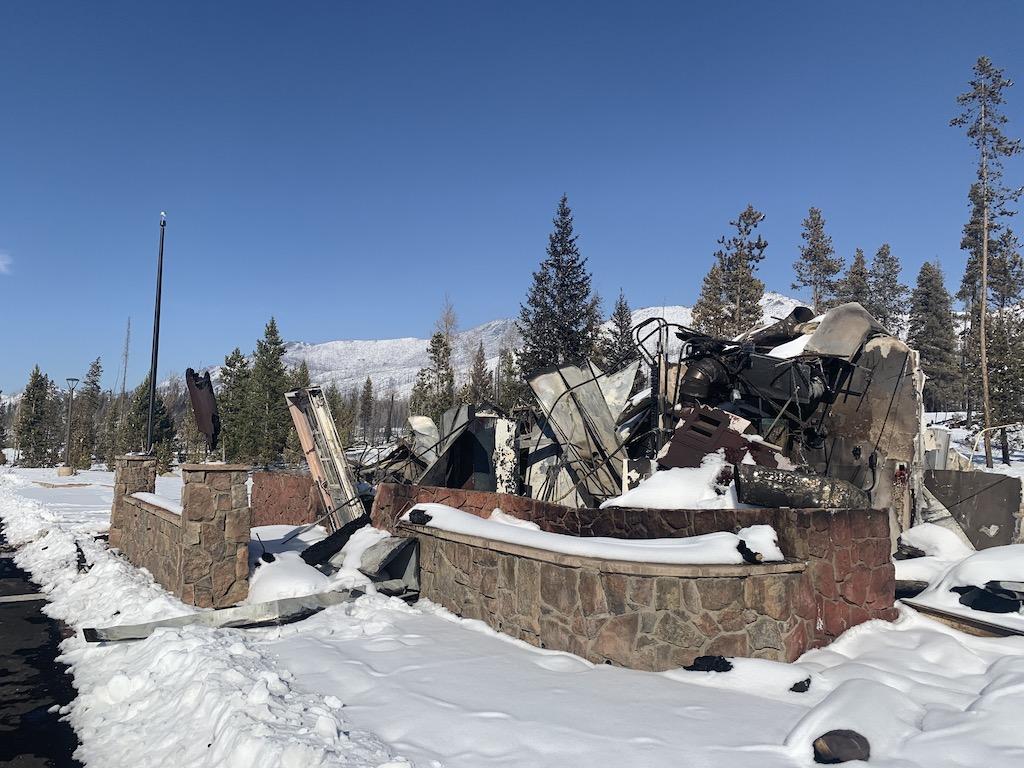
The Grand Lake Entrance Station was destroyed by the East Troublesome Fire/NPS
Though fires still are burning within Rocky Mountain National Park, they are in remote locations, allowing park staff to begin assessing the losses the park suffered from wildfires this year.
“This has been a challenging fire year for us and for all Coloradoans,” said Superintendent Darla Sidles. “Our staff are part of these communities, and our hearts go out to all our friends, family, and neighbors who have suffered and lost as a result of these fires.”
The East Troublesome and Cameron Peak fires blackened nearly 30,000 acres within the park, and the Grand Lake Entrance Station and other structures were destroyed by flames from the East Troublesome Fire. On October 22 the national park closed due to the fire. On Friday it began to reopen some areas.
When the East Troublesome Fire grew more than 100,000 acres in one day and swept through a portion of the park, a number of park structures were lost. Some of the structures that burned in the fire include the park’s Trails and Tack Barn and all its contents, the Grand Lake entrance station office, sparing the entrance kiosks themselves, the historic Onahu Lodge and Green Mountain cabins and the Harbison Meadows vault toilet facility.
The four-bay garage structure at Trail River Ranch and all its historic contents within were lost. The main park housing area, the Kawuneeche Visitor Center, the Trail River Ranch main building and Buckaroo Barn were all spared.
At this time, in some remote locations, the fires are still active, and a number of hazards persist, park staff said Friday. As the fires are contained and hazards mitigated, staff will provide a more thorough assessment of all the structures that have sustained loss and damage.
"It pains our hearts to see the loss of cherished structures like the Green Mountain cabins and Onahu Lodge, located along Trail Ridge Road in the Kawuneeche Valley,” said Sidles. “Both were eligible for the National Register of Historic Places for their rustic design and association with early 20th century development of ranching and resort industries. But more importantly they represented an important part of our shared history and culture and were cherished landmarks. They were also where many of our seasonal staff were housed.”
On the east side of the park, the historic Fern Lake Backcountry Patrol Cabin was lost. “The Fern Lake Backcountry cabin was constructed in 1925. It’s the oldest structure that burned. In 95 years, countless rangers, wilderness crews, trails crews, biologists, and search and rescue operations have been based and supported out of this cabin,” said Sidles.
One success the park has seen in the wake of these large wildfires lies in the fire mitigation and fuels management efforts over the last two decades.
“It was recognized over 20 years ago that Estes Park and other communities adjacent to the park were at risk from wildfire,” said Fire Management Officer Mike Lewelling. “Over that time, there was a realization that wildfires are getting larger nationwide, fire seasons are getting longer and to make matters worse, the mountain pine beetle outbreak created a fuels profile that is very volatile.”
The park’s fire program has engaged in fuels management practices for a while and over the last five years have put together a more comprehensive fuels program with the goal of creating a "catcher’s mitt" around Estes Park and other areas of the park boundary near Allenspark and Lily Lake. More aggressive fuels reduction projects including thinning and prescribed fire have been implemented along the park boundary; along roads and trails; and around park buildings, housing, and other infrastructure.
"It was widely accepted that these fuels treatments on their own would probably not stop a fire, but they give firefighters a chance,” added Lewelling. “On the west side of the park, fuels treatments were instrumental to protect the Kawuneechee housing and visitor center. On the east side, fuels treatments slowed fire spread, reduced tree torching which causes spot fires, and reduced the intensity allowing firefighters to be more aggressive and go direct.”
The fires burned in spruce-fir and lodgepole pine forests with a high-degree of beetle-killed trees, ponderosa pine woodlands, and upland meadows. Due to the extreme dry conditions, the fire also burned through ecosystems that would otherwise be expected to buffer fire effects such as some of the wetlands, riparian areas, and aspen groves.
While fire is a natural process, natural recovery could be hampered by changed environmental conditions and the enhanced spread of exotic plants. In addition, before plant cover re-establishes, more water runoff is anticipated, which could affect downstream ecosystems, infrastructure, and water systems.
Rocky Mountain National Park will prepare a Burned Area Emergency Response (BAER) Plan that will assess the burned area and potential for post-fire disturbance and recommend activities to mitigate these impacts when possible. The park also will pursue research and monitoring opportunities to track and understand post-fire effects and recovery.
"We will continue to assess additional areas in the park that we can reopen when it is safe to do so,” said Sidles. “The natural resources will recover with new life sprouting up in the fire’s footprint, and we will move forward and continue to do our best to manage Rocky Mountain National Park to preserve the natural and cultural resources for the enjoyment, education, and inspiration of this and future generations.”



Comments
Creating a "catcher's mitt" is a worthless excercise. Fires jump 10s of miles and no 100yd clear cut it going to stop it. According to the Forest Service's chief fire scientist, Jack Cohen, any efforts more than 250 feet from a structure is a waste of time. Fire mitigation should focus on the structure and immediate surrounding areas. Furthermore, while beetle kill can catch fire easier, once the needles drop (typically within a year) it burns less intensly and is not prone to crown fires which are the major cause of fire spread.